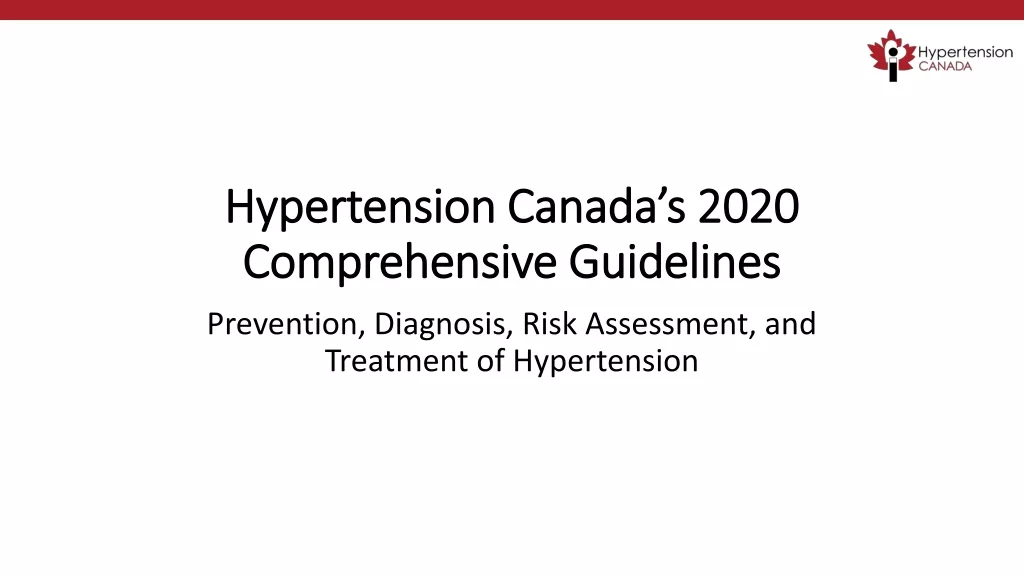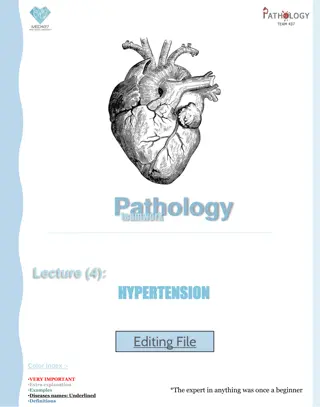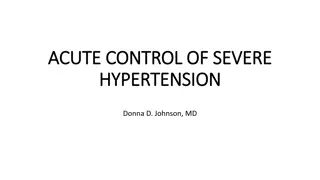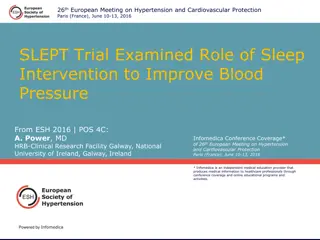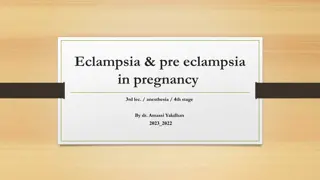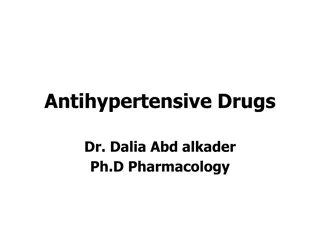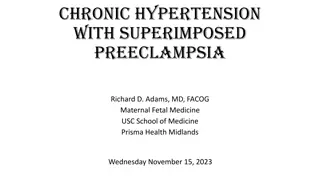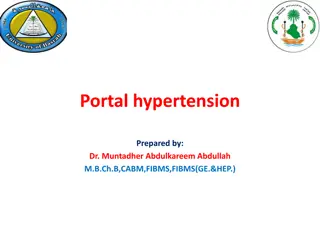Hypercalcemia and Hypertension Relationship
Hypercalcemia is a condition characterized by high levels of calcium in the blood, potentially leading to various health issues. This content explores the potential connection between hypercalcemia and hypertension, discussing causes, diagnostic procedures, manifestations, and possible implications for the patient. Topics include primary or secondary hypertension, the probable causes of hypercalcemia, variations in serum parathyroid hormone levels, primary hyperparathyroidism versus familial hypocalciuric hypercalcemia, the role of urinary calcium excretion in diagnosis, manifestations in patients, the utility of sestamibi scans, the probable type of hyperparathyroidism present, the etiology of gynecomastia, and the potential link between hyperparathyroidism and hypertension. Visual aids and explanations enhance the understanding of these complex medical conditions.
Download Presentation

Please find below an Image/Link to download the presentation.
The content on the website is provided AS IS for your information and personal use only. It may not be sold, licensed, or shared on other websites without obtaining consent from the author.If you encounter any issues during the download, it is possible that the publisher has removed the file from their server.
You are allowed to download the files provided on this website for personal or commercial use, subject to the condition that they are used lawfully. All files are the property of their respective owners.
The content on the website is provided AS IS for your information and personal use only. It may not be sold, licensed, or shared on other websites without obtaining consent from the author.
E N D
Presentation Transcript
1 Primary or secondary HTN? 1 2 What is the probable cause of hypercalcemia in this patient? 3 Is there any variation in PTH level in serum? 4 Primary hyperparathyroidism or FHH? 5 Is urinary calcium excretion useful for diagnosis? 6 What about manifestations in our patient? 7 What is the utility of sestamibi scan? 8 What is the probable type of hyperparathyroidism in the patient? 9 What is the etiology of gynecomastia? 10 Could hyperparathyroidism be the cause of hypertension in our patient? 11
Primary or secondary HTN? 1 1 What is the probable cause of hypercalcemia in this patient? 2 3 Is there any variation in PTH level in serum? 4 Primary hyperparathyroidism or FHH? 5 Is urinary calcium excretion useful for diagnosis? 6 What about manifestations in our patient? 7 What is the utility of sestamibi scan? 8 What is the probable type of hyperparathyroidism in the patient? 9 What is the etiology of gynecomastia? 10 Could hyperparathyroidism be the cause of hypertension in our patient? 11
Primary or secondary HTN? 1 1 What is the probable cause of hypercalcemia in this patient? 2 3 Is there any variation in PTH level in serum? 4 Primary hyperparathyroidism or FHH? 5 Is urinary calcium excretion useful for diagnosis? 6 What about manifestations in our patient? 7 What is the utility of sestamibi scan? 8 What is the probable type of hyperparathyroidism in the patient? 9 What is the etiology of gynecomastia? 10 Could hyperparathyroidism be the cause of hypertension in our patient? 11
Primary or secondary HTN? 1 1 What is the probable cause of hypercalcemia in this patient? 2 3 Is there any variation in PTH level in serum? 4 Primary hyperparathyroidism or FHH? 5 Is urinary calcium excretion useful for diagnosis? 6 What about manifestations in our patient? 7 What is the utility of sestamibi scan? 8 What is the probable type of hyperparathyroidism in the patient? 9 What is the etiology of gynecomastia? 10 Could hyperparathyroidism be the cause of hypertension in our patient? 11
Parathyroid hormone is secreted in three distinct ways: tonic secretion circadian dynamics (with the highest amount secreted in the morning and lowest in the evening) a pulsatility that appears to be stochastic (occurring unpredictably, ten or more times a day). Most parathyroid hormone is secreted continuously
Primary or secondary HTN? 1 1 What is the probable cause of hypercalcemia in this patient? 2 3 Is there any variation in PTH level in serum? 4 Primary hyperparathyroidism or FHH? 5 Is urinary calcium excretion useful for diagnosis? 6 What about manifestations in our patient? 7 What is the utility of sestamibi scan? 8 What is the probable type of hyperparathyroidism in the patient? 9 What is the etiology of gynecomastia? 10 Could hyperparathyroidism be the cause of hypertension in our patient? 11
0.01 0.02
Primary or secondary HTN? 1 1 What is the probable cause of hypercalcemia in this patient? 2 3 Is there any variation in PTH level in serum? 4 Primary hyperparathyroidism or FHH? 5 Is urinary calcium excretion useful for diagnosis? 6 What about manifestations in our patient? 7 What is the utility of sestamibi scan? 8 What is the probable type of hyperparathyroidism in the patient? 9 What is the etiology of gynecomastia? 10 Could hyperparathyroidism be the cause of hypertension in our patient? 11
retrospective study of 1000 patients who underwent parathyroid surgery for pHPT over 11 years CCCR was: less than 0.01 for 19.0% between 0.01-0.02 for 43.7% greater than 0.02 in 37.3%.
Primary or secondary HTN? 1 1 What is the probable cause of hypercalcemia in this patient? 2 3 Is there any variation in PTH level in serum? 4 Primary hyperparathyroidism or FHH? 5 Is urinary calcium excretion useful for diagnosis? 6 What about manifestations in our patient? 7 What is the utility of sestamibi scan? 8 What is the probable type of hyperparathyroidism in the patient? 9 What is the etiology of gynecomastia? 10 Could hyperparathyroidism be the cause of hypertension in our patient? 11
USA and Canada : primary hyperparathyroidism predominantly presents as an asymptomatic disorder. Europe: Similar to the epidemiology in North America, primary hyperparathyroidism in Europe most often presents as an asymptomatic disorder. Asia In Asia, primary hyperparathyroidism is more likely to present with more marked hypercalcaemia and target organ involvement than in other regions of the world.
Classical Features The Kidney: Renal involvement can take the forms of : Hypercalciuria Nephrolithiasis Nephrocalcinosis reduced renal function stones and/or nephrocalcinosisis actually present in 21% to 55% of patients with asymptomatic PHPT.
The bone DXA is used to determine the advisability of surgery in asymptomatic patients. Typically, bone loss is greatest at the forearm (33% radius), a skeletal site that is almost totally comprised of cortical bone, and least at the lumbar spine, a skeletal site with a large component of trabecular bone Patients who do not have distal forearm measurements may have unrecognized but substantial cortical bone loss.
Primary or secondary HTN? 1 1 What is the probable cause of hypercalcemia in this patient? 2 3 Is there any variation in PTH level in serum? 4 Primary hyperparathyroidism or FHH? 5 Is urinary calcium excretion useful for diagnosis? 6 What about manifestations in our patient? 7 What is the utility of sestamibi scan? 8 What is the probable type of hyperparathyroidism in the patient? 9 What is the etiology of gynecomastia? 10 Could hyperparathyroidism be the cause of hypertension in our patient? 11
Parathyroid Localization Modalities: What Imaging to Perform and When Imaging has no utility in confirming or excluding the diagnosis of pHPT. Imaging results should not be used to select patients for surgical referral. Patients with negative imaging results remain candidates for parathyroidectomy. When imaging with initially negative results is performed again at high volume centers, the sensitivity of localization improves to as high as 92%. Imaging is performed after deciding to proceed with parathyroidectomy and is performed for operative planning.


